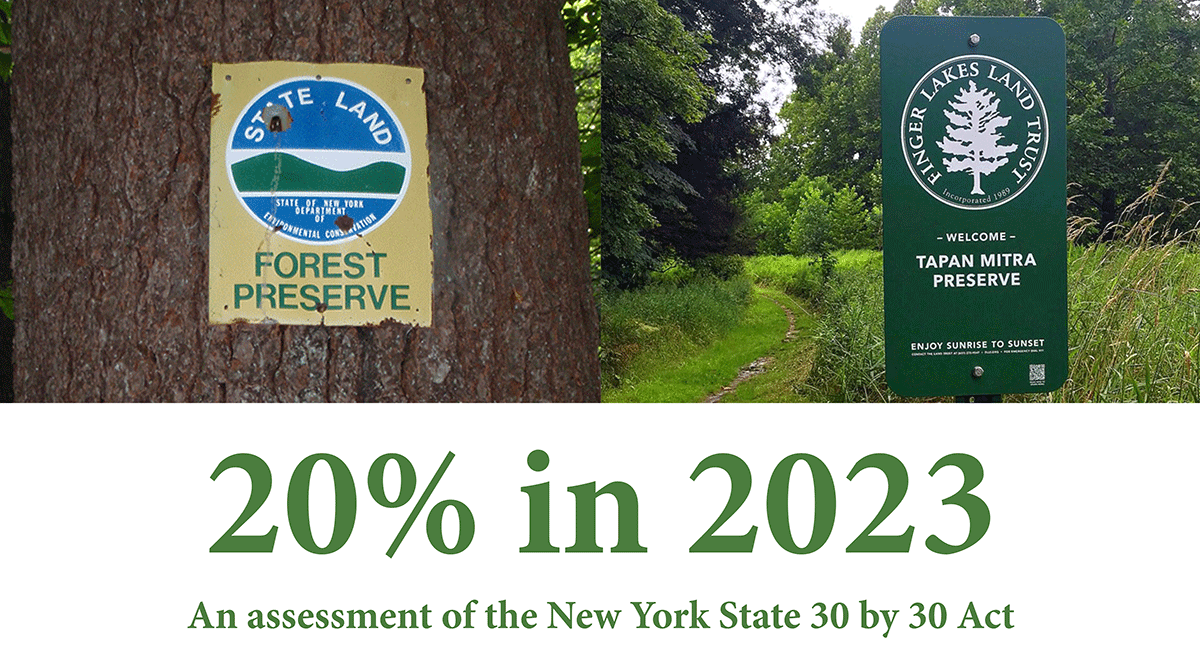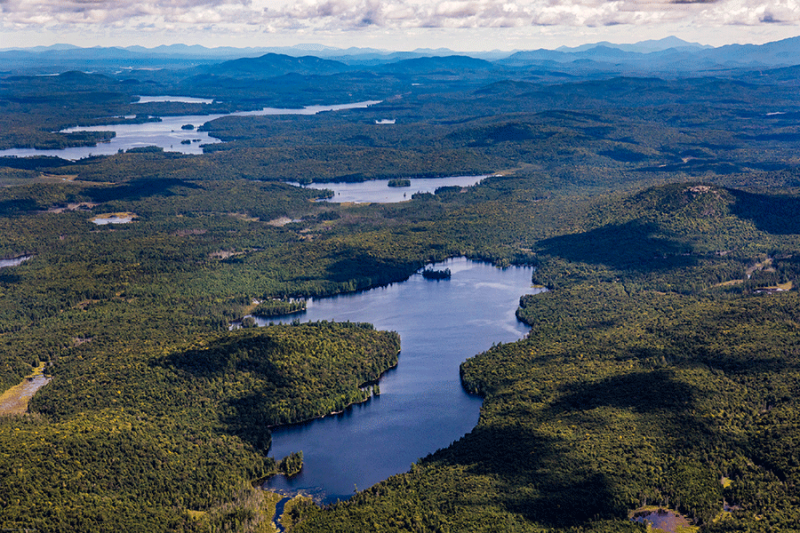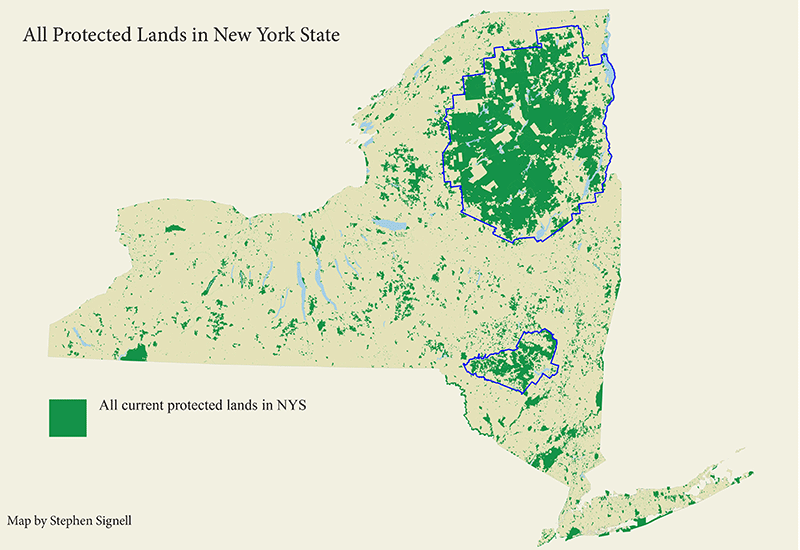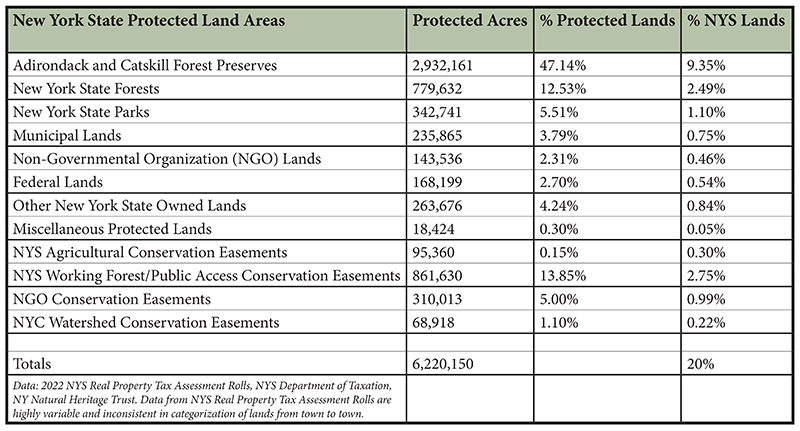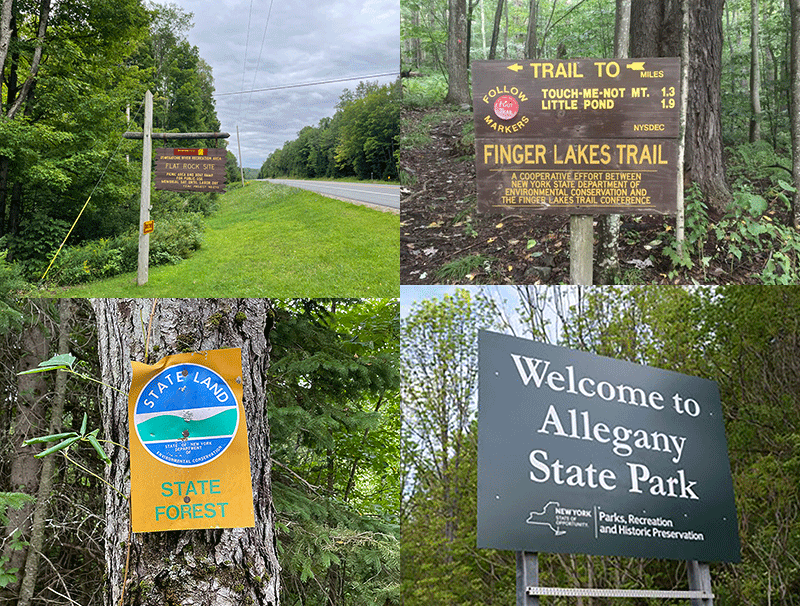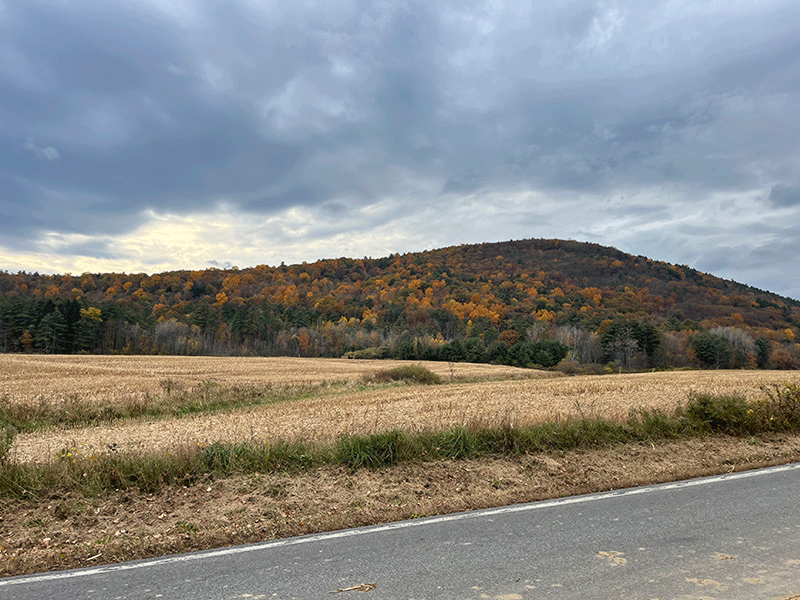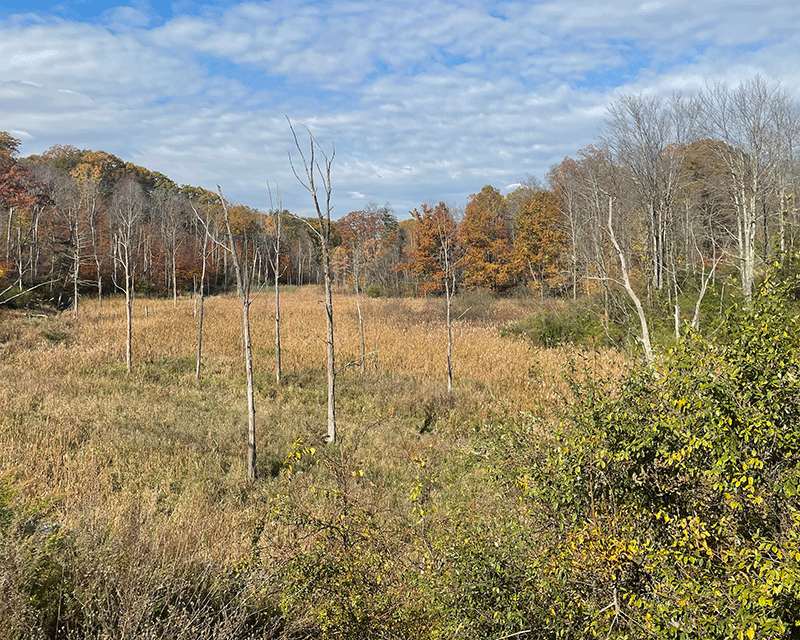Across New York State 6,220,150 acres, some 20% of the state, have been protected by state and local governments, private organizations, and the federal government, and another 3,190,806 acres need to be protected to meet the 30 by 30 goal.
Introduction
In 2022, Governor Kathy Hochul signed the “30 by 30” law, which establishes a conservation goal for New York State of protecting 30% of the State’s “lands and inland waters” by the year 2030. This landmark environmental protection legislation enjoyed broad bipartisan support, passing the State Senate by a vote of 58 to 3, and the State Assembly by a vote of 137 to 8. The 30 by 30 law commits New York to do its part to reach a similar national goal established by President Joe Biden in 2021 (to protect 30% of the nation’s lands and waters by 2030) and is a major step forward to protect New York’s open spaces, forests, and wetlands, which are cornerstones of the State’s long-term climate resilience and mitigation efforts. It is also an important step on the road to fulfilling legendary ecologist E.O. Wilson’s vision of keeping half of the earth as protected, intact, wild, and natural systems.
Click here to read the full report 20% in 2023: An Assessment of the New York State 30 by 30 Act.
Click here to read a press release about this new report.
The 30 by 30 legislation requires the Department of Environmental Conservation (DEC) to prepare a plan by July 1, 2024, that shows how much of New York State’s lands and waters are currently conserved and the amount that needs to be protected in the years ahead to meet the 30% by 2030 goal. The DEC is drafting this plan in concert with the Office of Parks, Recreation, and Historic Preservation (OPRHP).
The 30 by 30 Act states: “It shall be the goal of the state to support and contribute to national efforts to conserve at least thirty percent of United States lands and inland waters and at least thirty percent of United States ocean areas by the year two thousand thirty.” Protect the Adirondacks has evaluated what it means to conserve lands and waters in New York and assessed the status of current protected lands and waters across the state. New York State encompasses 31,369,853 acres of land and inland waters.
Protect the Adirondacks’ analysis concludes that 6,220,150 acres (see chart below) of lands and waters are currently protected in a variety of ways, creating a legacy and heritage of ambitious land conservation. These wild places include 2.9 million acres of Forest Preserve in the Adirondack Park and Catskill Park; over 850,000 acres of state-held conservation easements; over 700,000 acres of State Forests; nearly 350,000 acres of State parklands; and over 235,000 acres of municipal park lands, county forests, and watershed lands. Other protected areas include conservation easements and lands owned by land trusts and conservation organizations, totaling approximately 500,000 acres, and agricultural easements held by the State totaling over 100,000 acres. Changes to the State’s Freshwater Wetlands Act in 2022 could also add significant wetland acreage to protected areas in New York.
The 30 by 30 legislation builds upon the multi-generational and bipartisan legacy of land protection by New York State, which has been in the land protection business in a serious way for over 175 years. Efforts to build Central Park in Manhattan and Prospect Park in Brooklyn started in the 1850s. In 1864, there was a call to protect the vast wildlands in the Adirondacks to create a “central park for the world.” Van Cortlandt Park in the Bronx was started in the 1870s at the same time that Upstate cities, like Rochester and Albany, built large public parks. In 1885 the Forest Preserve was created in the Adirondacks and Catskills. That year also saw the creation of the Niagara Reservation, which later became Niagara Falls State Park in the early 20th century. In 1892, the Adirondack Park was created, followed by the Catskill Park in 1904. Bear Mountain State Park opened in 1913 and dozens of parks have followed.
The constitutional “Forever Wild” protections for the Forest Preserve and the State parks system, the passage of a half dozen environmental bond acts to protect land, and creation of the Environmental Protection Fund show that New Yorkers have always placed a high value on land protection, generation after generation. In order to reach the goal of protecting 30% of New York’s lands and waters, a total of 9,410,956 acres, some 3,190,806 acres will need to be protected by 2030. Reaching this goal will be a monumental challenge for New York State and requires a sustained commitment from State leaders, State agencies, land trusts and conservation organizations, and local governments in all corners of the state.
What Lands are Protected?
Protect the Adirondacks conducted a statewide assessment of the status of protected lands in New York. The first thing we did was determine what it means for land or water to be conserved. We looked at different categories of lands across New York and determined that in order to be considered conserved lands must be permanently protected, subject to some form of legal limitation on development or conversion to other uses. To do this analysis we looked at the Real Property Tax Assessment Rolls for all communities across the state and various open-source GIS data. In our assessment of protected lands, we identified 12 categories totaling 6,220,150 acres that enjoy some form of permanent legal protection and should count towards the goal of protecting 30% of lands by 2030. Following is a detailed list and explanation of these categories.
Adirondack and Catskill Forest Preserves: Created in 1885, and granted “forever wild” protection in the State Constitution in 1894, Forest Preserve lands are located in counties of the Adirondack and Catskill Parks and are managed by the DEC. The Forest Preserve is protected by Article 14 of the New York State Constitution, which states that these lands cannot be leased, sold or exchanged, and that Forest Preserve trees cannot be sold, removed or destroyed. In every decade since 1885, the State has purchased additional lands to add to the Forest Preserve. These lands total 2,932,161 acres.
New York State Forests: These State-owned forestlands are managed by DEC and located outside of the Adirondack and Catskill Parks. They are primarily used for public recreation, but some are managed for State-supervised timber production, which does not conflict with our definition of “protected” because the land cannot lawfully be developed for other purposes. However, approximately 4% of the nearly 780,000 acres of State Forests are subject to oil and gas exploration and development, and therefore do not meet the definition of “protected.” There are dozens of State Forests areas throughout the state. These lands total 779,632 acres.
New York State Parks: These are State-owned lands and waters, managed by OPRHP, and include more than 250 parks, historic sites, and recreational areas. These lands total 342,741 acres.
Municipal Lands: These are lands owned by a municipality for conservation purposes, such as parks, forests, watersheds, beaches, and open space. These lands total 235,865 acres.
Non-Governmental Organization (NGO) Lands: These are lands owned by a bona fide NGO, designated as a tax-exempt public charity under Section 501(c)(3) of the Internal Revenue Code, for conservation or natural resource protection. These lands total 143,536 acres.
Federal lands: Federal lands in New York total over 168,000 acres. These lands includes the 16,212-acre Finger Lakes National Forest, the 23,000-acre Montezuma National Wildlife Refuge, the 19,000-acre Fire Island National Seashore, 30,000-acre Upper Delaware Scenic and Recreational River (Delaware Water Gap), 3,000-acre Oyster Bay National Wildlife Refuge, among dozens of other lands.
Other New York State Owned Lands: The State also manages State Wildlife Refuges, and State Wildlife Management Areas lands owned by Public Authorities, or lands owned by the NYS Power Authority, among other land types. These lands total 263,676 acres.
Miscellaneous Protected Lands: This is a small amount of lands classified under the Real Property Tax Assessment Rolls as protected or State-owned. These lands total 18,424 acres.
New York State Agricultural Conservation Easements: These are private lands on which the State owns certain rights in perpetuity. The legal rights owned by the State typically conserve viable agricultural lands and preclude the private landowner from converting those lands to non-farm uses, and may also include public access, open space, scenic views, historic sites, and other natural resource protection rights. An Agricultural Conservation Easement allows the landowner to conduct sustainable agricultural practices on the property. Data provided from NYS Department or Agriculture and Markets listed individual easements totaling 95,360 acres. Ag and Markets stated that this was not the entire list of such easements, but a complete list was not available. Press Releases from Governor Hochul have cited a figure of 107,000 acres.
New York State Working Forest and Public Access Conservation Easements: These are private lands on which the State owns certain rights in perpetuity. The legal rights owned by the State may include public access, open space, scenic views, historic sites, and natural resource protection rights, and may preclude the private landowner from developing some or all of the property. A Working Forest Conservation Easement generally allows the landowner to sustainably manage the timber on the property under the supervision of a professional forest management program. These lands total 861,630 acres.
Non-Governmental Organization (NGO) Conservation Easements: These are private lands on which a bonafide NGO, qualified under Article 49, Title 3, of the New York State Environmental Conservation Law (ECL), to receive and hold a conservation easement, owns certain rights to the property in perpetuity. The legal rights owned by the NGO may include public access, open space, scenic views, historic sites, and natural resource protection rights and preclude the private landowner from developing some or all of the property. Specified activities such as forest management, agriculture, and recreation, are often allowed. These lands total 310,013 acres.
New York City Watershed Conservation Easements: These are private lands on which New York City owns certain rights to the property in perpetuity. The legal rights owned by New York City generally include rights that restrict development activities on and around the watershed lands and waterbodies on the property for the purpose of protecting/improving water quality. The landowner may be allowed to continue certain uses of the property, such as houses, garages and barns, and may retain rights for forest management and recreational activities on the property. These lands total 68,918 acres.
While laws could be changed, the public lands listed as protected in this report would have to undergo a significant public review process prior to any change in their status. For example, the constitutional provisions protecting the 2.9-million-acre Forest Preserve can only be changed through a lengthy constitutional amendment process that includes passage in two consecutive legislative sessions and approval in a statewide referendum. Local governments cannot alienate municipal parklands without the approval of the State Legislature. Land Trusts are governed by national policies that prioritize permanent protection of land.
Protect the Adirondacks is concerned that the State may try to inflate the amount of currently protected lands in New York through loose or expansive definitions of what the term “protected” means. For instance, will the State claim that all of the lands within the 6-million-acre Adirondack Park are protected because private lands in the Park are subject to regional land use controls under the Adirondack Park Agency Act? The Adirondack Park includes state and town highways and fully developed communities like Lake Placid, Lake George, and Saranac Lake. Will the State argue that all surface waters of the state’s lakes and ponds are protected? Are lake bottom lands protected? Are coastal waters protected? Do lands zoned with various restrictive laws count as protected? Will lands that are enrolled in Preferential Forest Tax Law programs, commonly referred to as “480” and “480-A” lands, count as protected? These are important questions to determine the calculation of protected lands.
3 Million Acres to Go
Protect the Adirondacks’ analysis concluded that approximately 20% of New York’s lands and inland waters is protected in 2023, some 6,220,150 acres. Thus, we believe that an additional 3,190,806 acres will need to be protected by 2030 in order to reach the statutory goal of the 30 by 30 law. DEC and OPRHP recently announced that work has begun to update the New York State Open Space Conservation Plan. Regional Advisory Committees have formed and are preparing land lists and a draft updated plan will be released for public hearings in 2024. With the State committed to protecting another nearly 3.2 million acres by 2030, the 30 by 30 law should play a major role in the focus and objectives of the updated Open Space Plan.
Question of Protected Wetlands
There are an estimated 2.4 million acres of wetlands in New York, comprising just under 8% of the State’s total land area. Of these, over 900,000 acres of wetlands are in the Adirondack Park, over 150,000 acres are in the Hudson Valley, over 400,000 acres are in the Appalachian-Hudson Highlands, and over 880,000 acres are associated with lake plain systems in the Finger Lakes and Great Lakes. Hundreds of thousands of acres of wetlands located in the Forest Preserve and on State working forest easements are protected. The most common wetland cover type across New York is forested (70%), followed by shrub/scrub (16%), emergent (9%), and wetland open water (5%).
The New York State Freshwater Wetlands Act (FWA) was passed in 1975. In 2022 the FWA was amended to reduce the threshold for a regulated wetland from 12.4 acres to 7.4 acres starting in 2028 and allows for even smaller wetlands of “unusual importance” to be protected through regulation. Proponents of the amendments noted that the 2022 changes would protect an additional one million acres of wetlands in New York. However, it is important to note that the FWA does not prohibit development in or adjacent to wetlands; rather, it imposes a permit requirement for most types of development occurring in and around wetlands.
The DEC is now drafting criteria for determining which small wetlands will qualify for classification as being of “unusual importance” and thus subject to permitting requirements. When these rules are finalized and the wetland minimum size level is dropped to 7.4 acres in 2028, it will be interesting to evaluate what percent of the state’s 2.4 million acres of wetlands will actually be permanently protected. It will also be interesting to see if the State considers regulated wetlands to be “protected” within the meaning of the 30 by 30 legislation and, if so, the basis for that determination. In Protect the Adirondacks’ experience, status as a regulated wetland under the FWA does not necessarily mean protection. For example, the Adirondack Park Agency, which administers and enforces the FWA in the Adirondack Park, recently approved a major expansion of a commercial marina affecting thousands of square feet of protected wetlands without even requiring submission of a wetland permit application.
According to research by Protect the Adirondacks, there are over 12 million acres of currently unprotected open space across New York State in approximately 253,000 parcels ranging in size from 10 acres to over 100 acres. These parcels present a golden opportunity for the State to protect significant acreages of forestlands and unique habitats that can help the State meet its 30 by 30 goal.
Opportunities for Land Protection Exist Across New York State
According to the Real Property Tax Assessment Rolls, lands in parcels measuring between 10 to 25 acres in size, and classified as lightly developed or as open space, total over 1.7 million acres. This land base exists in over 111,000 individual parcels. Lands classified as open space in parcels measuring 25 to 50 acres total 2.33 million acres, and are distributed in over approximately 65,000 parcels. Lands classified as open space in parcels measuring 50 to 100 acres total 3.44 million acres, and are distributed in over 49,000 parcels. Lands classified as open space in parcels measuring over 100 acres total over 4.85 million acres, and are distributed in over 28,000 parcels.
Given the undeveloped open spaces that remain across New York State, the land base clearly exists to meet the 30 by 30 goal and permanently protect lands from future development. To reach the State’s 30 by 30 goal, new lands will need to be protected through a variety of programs. State leaders need to re-ignite land protection at state agencies and explore new programs that protect open spaces.
Recommendations
To meet the 30 by 30 goal to conserve 30% of New York State’s land and inland waters by 2030, a total of 3,190,806 acres will need to be protected. This is an audacious objective for State leaders and communities across New York. Protect the Adirondacks believes that this goal is attainable for the State of New York and can be accomplished through a number of different programs and with a number of different partners.
1. The Hochul Administration Should Set a Goal of Protecting 1,000,0000 Acres through State Acquisition by 2030.
There is precedent for accelerated state action on land protection. The Pataki Administration protected over 1 million acres across New York in a 10-year period in the late 1990s through 2006. The goal of acquiring 1 million acres can be achieved by purchasing lands in fee and conservation easements. For example, the 1-million-acre goal can be achieved by expanding the Forest Preserve by 250,000 acres, State Parks by 75,000 acres, State Forests and other state lands by 100,000 acres, Working Forest Conservation Easements by 500,000 acres, and agricultural easements by 75,000 acres. The 2022 Clean Water, Clean Air and Green Jobs Environmental Bond Act has approximately $2.275 billion in funding that is allocated to protect lands and waters in New York State, and the $400 million Environmental Protection Fund is also a source of annual funding for land purchases. Significant new land protection funding will also be necessary between now and 2030.
2. New Open Space Conservation Plan Should Make 30 by 30 its Top Priority.The New York State Open Space Conservation Plan is currently in the early stages of revision. The first plan was approved in the early 1990s and last updated in 2016. The Open Space Plan is built on the work of nine Regional Advisory Committees made up of local government officials and various individuals selected by state agencies. The new Open Space Plan should have as its stated priority a commitment to achieve the State’s 30 by 30 goal.
3. The Adirondack Park Plays a Key Role in Meeting the 30 by 30 Goal.
The Adirondack Park contains large tracts of undeveloped and unprotected lands that would benefit from protection as additions to the Forest Preserve or by conservation easement. State planning for meeting the 30 by 30 goal should spotlight the key role that the Adirondack Park can play in meeting the state’s land conservation goals. From the 36,000-acre Whitney Park tract to the large tracts of commercial forestlands, there are critical opportunities for land protection that would enhance public access, expand Wilderness areas, and preserve managed forestlands. Land protection in the Adirondack Park is an investment in the economy and environment in the Adirondack Park and in the future of New York.
4. Merge 30 by 30 Goals with New York’s Climate Action Plan to Protect Nearly 2 Million Acres by 2030.
The goals of the 30 by 30 law should be merged with the state’s Climate Action Plan prepared under the Climate Leadership and Community Protection Act (CLCPA). Land protection should be a cornerstone of CLCPA planning complementing expansion of alternative energy sources, conservation, and improving the state’s transmission and electrical grid. One weakness of the state’s Climate Action Plan is the absence of a private forest land management program where lands are permanently protected by some form of “forever wild” state easement for the purpose of carbon sequestration and long-term carbon storage. New York needs this type of program because there are many forestland owners across the state who are not interested in managing their lands for commercial forestry and would be interested in a state program providing payments and long-term tax benefits in exchange for permanent open space protection and carbon storage. Our research estimates that there are over 12 million acres of lands that are lightly developed or in open space and would be suitable for this type of program. The state should set a goal of protecting two million acres through a new climate-change-based forest management program. Such a program would meet objectives for both 30 by 30 and the CLCPA.
5. Land Trusts and Private Institutions in New York Should Protect Over 190,000 Acres.
As part of the New York State’s 30 by 30 goal, land trusts and private organizations should permanently protect over 190,000 additional acres by 2030. These lands enjoy flexibility in the conservation management that allow private uses, and some public uses, yet protect the land’s most important natural resources.
6. State Agencies Need to Improve and Streamline Land Purchasing Procedures.
The Department of Environmental Conservation needs to add additional staff to its Real Property Office to improve the State’s ability to buy lands. The State Comptroller, Attorney General, and DEC Commissioner need to streamline State land acquisition procedures to shorten the time that it takes to complete a purchase.
Conclusion
Protect the Adirondacks has identified over 6.2 million acres of protected lands out of the 9.4 million acres that need to be protected to meet the 30 by 30 statutory goal of protecting 30% by 2030. There are 12 million acres of unprotected open space lands across New York that offer prime opportunities for protection to reach the 30 by 30 goal. The revised New York State Open Space Conservation Plan can set the blueprint for the State’s acquisition of 1 million acres of lands and waters, with a particular focus on the Adirondack Park. Another 2 million acres of land can be protected by creating incentives for private landowners to preserve forests to meet the climate change goals in New York’s Climate Action Plan and through protection actions by private land trusts and other NGOs. There is a clear pathway for the State of New York to protect another 3.2 million acres and reach the goal set forth in the 30 by 30 legislation.
Click here to see charts of current protected lands in all 62 counties in New York.

